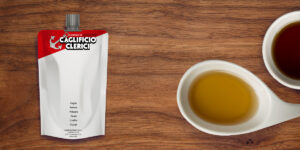
Tradition Gets a Makeover: New Sustainable Packaging for Clerici Liquid Rennet
At Caglificio Clerici, we understand that every activity we undertake has a significant impact on the environment and the people […]
Food-grade wax (or wax coating) for cheeses is a protective safe layer made from microcrystalline wax which covers the product, forming a barrier against environmental contamination.
The outer layer of wax protects the cheese from pre-sale handling and helps to retain its flavour; its purposes is to maintain the high quality of the dairy product as well as its intrinsic organoleptic characteristics.
The wax coating for cheese comes in the form of solid slabs to be melted in special temperature-controlled vats.
Microcrystalline wax contains a high percentage of branched alkanes and cycloalkane which makes it stouter and much more compact than paraffin wax.
When you use microcrystalline wax rather than paraffin to cover cheese, you cut down on the number of times you need to dip the product in order to coat it. One or two dips at the most are all you need. This does away with the tendency of melted paraffin to create a characteristic oxidation.
Another definite difference lies in crystal size because the grain is finer in the case of microcrystalline wax (as you might guess from the name); what this means is that the food wax provides greater coverage, a brighter colour, better viscosity and a higher melting temperature.
Once the coating wax has been melted in temperature-controlled containers, it is applied to the product by a simple dipping process which takes place either manually or with mechanical devices (conveyor belts or overhead handlers). The cheese must be scrupulously clean.
Caglificio Clerici sells two kinds of food-grade wax for cheese: the first is more malleable for products weighing over 15kg whereas the second one is stiffer for smaller cheeses.
Clerici’s microcrystalline wax coatings are a clean-label product and available in a wide array of colours: in addition to the more traditional hues of yellow, red and black, we also offer shades like orange and green.
The following are part of Caglificio Clerici’s product portfolio: Intercer LU Colorless, Intercer LU C Red, Intercer LU C Yellow and Intercer LU C Black.